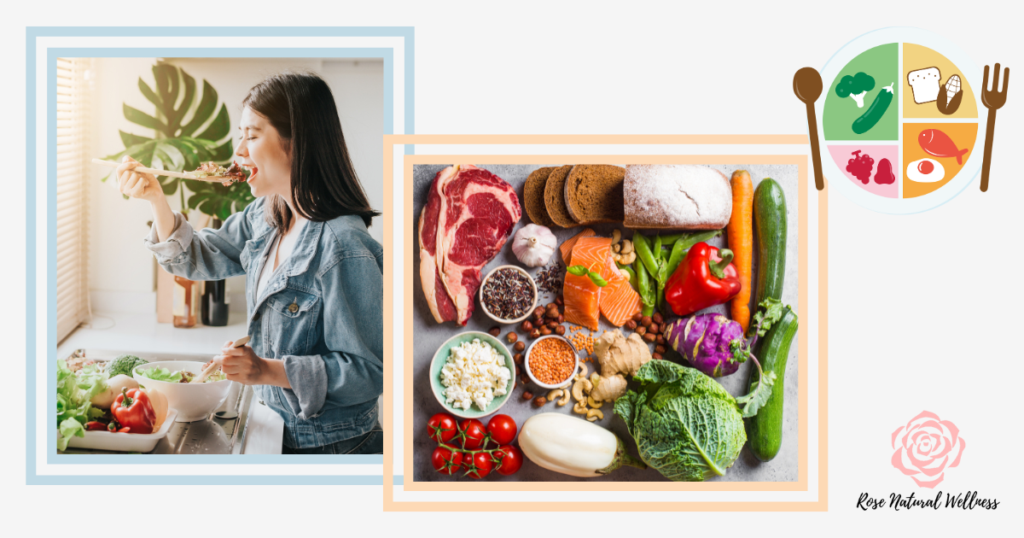
If you’ve ever felt tired after meals, struggled with cravings, or weren’t sure whether your food choices were actually supporting your health—you’re not alone. For many women, especially those 30 and up, understanding how to build a balanced plate can be the missing link to feeling energized, nourished, and in control.
In this article, we’ll break down exactly what a balanced plate looks like, why macronutrients matter, and how you can create satisfying, nutrient-dense meals without overthinking it. This isn’t about dieting—it’s about fueling your body in a way that works with your lifestyle.
At the heart of a balanced plate are macronutrients—carbohydrates, proteins, and fats. These are the nutrients your body needs in large amounts to function well every day.
This model is based on the MyPlate nutrition guide, which offers an excellent visual as to what a balanced plate should look like. Although the MyPlate nutrition guide doesn’t include a specific section for fats, it’s still important to include them, paying special attention to the quality of the fats that you eat. The standard American diet often contains too much saturated fat from ultra-processed foods and refined seed oils (like canola and vegetable oil), which may include trans fats due to hydrogenation. Trans fats are well known to cause increased risk for heart disease, cancer, obesity, and a wide range of other chronic illnesses. Therefore, it's important to limit trans fats as much as possible and prioritize healthy sources of dietary fats.
Healthy fat sources like fatty fish, walnuts, and chia seeds offer essential omega-3 fatty acids and provide vital anti-inflammatory benefits. While nuts and seeds are excellent sources of healthy dietary fat, they also give your body a boost of essential micronutrients that further support your health.
Dietary fats are an important part of our balanced plate as they are essential for health, however it's important to note that they are more calorie dense than protein and carbohydrates. In general, your total fat intake should stay below 30% of your daily calories, with an emphasis on natural, unprocessed fat sources.
For a deeper dive into macronutrients, this Healthline article gives a great breakdown of their functions.
For women, balanced eating isn’t just about calories—it’s about how those calories support hormone balance, mood, and energy.
Skipping meals or cutting out major food groups can lead to fatigue, irritability, and even disrupted hormone cycles. A steady intake of nutrient-dense meals fuels your body consistently, helping you:
According to Complete Healthcare’s article on women’s health, a balanced diet is crucial for everything from brain function to aging well. If you’re unsure about how much food your body needs, you can use our free caloric intake calculator to get a personalized baseline for understanding your calorie needs before planning your meals.
Here’s a simple formula to help you create a balanced plate:
Need inspiration? MyPlate.gov offers a variety of visual tools to help you build meals confidently.
Meal prep for a balanced diet doesn’t have to be complicated. Plan a few go-to meals, batch-cook ingredients, and mix and match throughout the week. With a little prep, simple healthy meals become second nature.
There’s a lot of confusion out there. Let’s address a few myths:
“Fat is bad.”
This simple shift can reduce cravings, increase satisfaction, and help support sustainable nutrition over time.
Healthy portion sizes and mindful eating are key. Over-restricting can backfire and lead to cravings or low energy.
Creating a balanced plate isn’t about following rigid rules—it’s about learning what feels good and fuels your life.
Start small. Pick one meal a day to balance more intentionally. Notice how you feel. Over time, you’ll build healthy eating habits that truly support your energy, hormones, and well-being.
Want to go deeper? Many women find that understanding their macronutrient balance—and what their unique body needs—can bring clarity and confidence to everyday choices. You can access free resources like the Women’s Caloric Intake Calculator or sign up for a free Discovery Call to get started. You don’t need a restrictive diet—you just need the right information, a little support, and a plate that works for you.